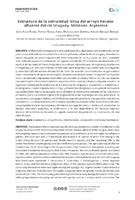Estructura de la comunidad íctica del arroyo Paraíso afluente del río Uruguay. Misiones. Argentina
Date
2020-06-09Author
Flores, Silvia Alicia
Araya, Patricia Raquel
Serrano, Marcelo
Barboza, Adriana Griselda
Hirt, Lourdes María
Metadata
Show full item recordAbstract
Se determinó la composición, diversidad específica, abundancia, número de endemismos y estructura trófica de la comunidad íctica del arroyo Paraíso, afluente del río Uruguay. Se realizaron cuatro campañas de pesca experimental entre setiembre de 2013 y marzo de 2015, utilizando ocho redes de espera monofilamento. La captura total fue de 217 individuos pertenecientes a 35 especies de las cuales el 77% corresponde a los órdenes Characiformes (16 especies) y Siluriformes (11 especies) y el 33% a los órdenes Cichliformes (siete especies) y Gymnotiformes (una especie). La diversidad alfa de número efectivo fue de 16,44. De acuerdo con el estimador no paramétrico Chao 1, el inventario de peces es incompleto, restaría encontrar al menos 16 especies. Las especies raras o accidentales representaron el 66%, con abundancia relativa inferior al 10%. Las especies comunes fueron Crenicichla missioneira, Leporinus amae, Leporinus striatus y Astyanax lacustris. Se registraron siete especies endémicas de la cuenca del río Uruguay: C. missioneira, C. celidochilus, C. tendybaguassu, L. amae, Astyanax parís, A. troya, y Hemiancistrus fulliginosus. La mayoría de las especies capturadas (83%) fueron de pequeño porte. El índice de dominancia comunitaria fue máximo en primavera (0,81). La materia orgánica de origen alóctono fue el principal recurso alimentario. Se reconocieron seis grupos tróficos y el 61,5% de las especies perteneció al grupo de los detritívoros u omnívoros. La comunidad presentó actividad reproductiva durante todas las estaciones del año, con preponderancia en la primavera y el invierno con especies como L. striatus y A. piracicabae. La elevada diversidad específica, el endemismo y la alta dependencia del material orgánico alóctono de la ictiofauna demanda la urgente necesidad de protección y conservación de este curso de agua. We analyzed the composition, specific diversity, abundance, number of endemism’s and trophic structure of the fish community of the Paraíso stream, affluent of the Uruguay River. Four fish samplings were carried out between September 2013 and March 2015, with eight monofilamen gillnets. The total catch was 217 individuals distributed in 35 species of which 77% belong to the orders Characiformes (16 species) and Siluriformes (11 species) and the remaining 33% to the orders Perciformes (seven species) and Gymnotiformes (one species). The alpha diversity of effectiv numbers was 16.44. According to the non-parametric Chao 1 estimator, the species inventory was incomplete it would be necessary to find at least 16 species. Rare or accidental species accounted for 66%, with relative abundance of less than 10%. Common species were Crenicichla missioneira, Leporinus amae, Leporinus striatus and Astyanax lacustris. Seven endemic species from the Uruguay River basin were registered: C. missioneira, C. celidochilus, C. tendybaguassu, L. amae, Astyanax paris, A. troya, and Hemiancistrus fulliginosus. Most of the species captured (83%) were small. The community dominance index was higher during the spring (0.81). Organic matter of allochthonous origin was the main food resource. Six trophic categories were recognized, mostly detritivores and omnivores (61.5%). The community presented reproductive activity during all seasons of the year, with a preponderance in spring and winter with species such as L. striatus and A. piracicabae. The high specific diversity, endemism and the high dependency of the allochthonous organic material of the ichthyofauna demand the urgent need of protection and conservation of this watercourse.
Collections
The following license files are associated with this item:



